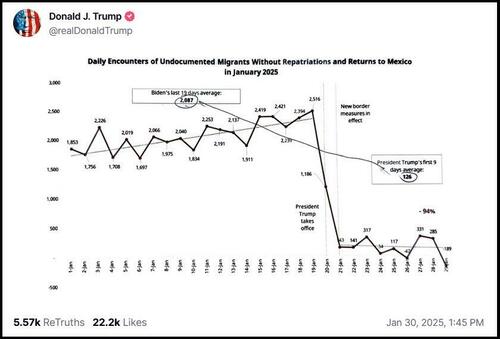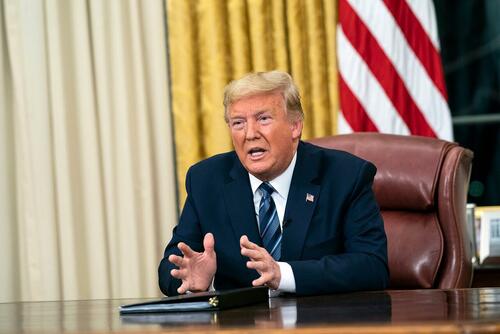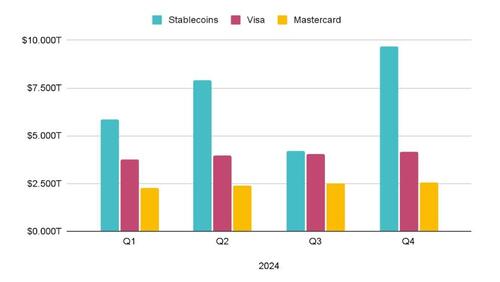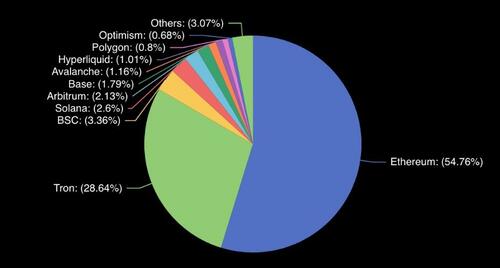Trade Wars Begin: Trump Slaps 25% Tariffs On Canada And Mexico, 10% On China
And just like that, the Trump trade wars have officially (re)started.
As was widely previewed yesterday, President Trump unleashed the first salvo of his latest trade war with tariffs of 25% on Canada and Mexico and 10% on China, the start of a wave of promised trade barrages against both foreign adversaries and allies.
Trump signed orders for the tariffs around 5pm ET on Saturday; they will go into effect on Tuesday, at which point they will likely escalate in tit-for-tat fashion until something breaks.
— Donald J. Trump (@realDonaldTrump) February 1, 2025
According to a fact sheet published by the White House, the tariffs are in response to the “extraordinary threat posed by illegal aliens and drugs” such as fentanyl, which constitute a national emergency under the International Emergency Economic Powers Act.
WH fact sheet on the new tariffs pic.twitter.com/Dqq30iWn5x
— Olga Nesterova (@onestpress) February 1, 2025
Perhaps the only difference from what was previously leaked is that energy imports from Canada will be spared from the full 25% levy and will face a 10% tariff. The White House officials said that was intended to minimize upward pressure on gasoline and home-heating oil prices.
The orders also include retaliation clauses that would increase US tariffs if the countries respond in kind. The tariffs issued on Saturday will be on top of existing trade levies on those countries.
White House Officials say there is a high bar for China, Canada, and Mexico to get tariffs removed. They say in President Trumps golden age it’s only legal immigration and no Americans dying of fentanyl. #Tariffs #Mexico #Canada #China
— Edward Lawrence (@EdwardLawrence) February 1, 2025
White House Officials say the Executive Orders signed adding tariffs on Canada, Mexico, and China have a retaliation clause. That means if the country retaliates, then there would be consequences. The Officials say likely increased tariffs. #Tariffs #Canada #Mexico #China
— Edward Lawrence (@EdwardLawrence) February 1, 2025
The order also revoked the so-called de minimis exemption for small parcels and packages, one official said, which will apply tariffs more widely to small shipments and impact e-commerce and online retailing. The US loses a tremendous amount of tariff revenue by using the exemption, one official said.
The three targeted countries are the largest three sources of US imports, accounting for almost half of total volume.
The decision is intended to have sharp economic impacts for the nations targeted; it will likely also impact the US depending on how much of the tariff-related price increases are passed through.
Parts of the US, including the Pacific Northwest and Northeast US, are deeply reliant on electricity or gas flows from Canada. And oil industry advocates have warned against even a 10% increase in the cost of crude inputs into Midwestern refineries that have few near-term options to substitute with US supplies.
For context, over 60% of US crude imports comes from Canada, so a 10% tariff on oil imports will lead to a prompt increase in the price of diesel which is the backbone of the US economy. Depending on the mood of the Fed on any given day, that may be seen as inflationary and lead to rate hikes in the near future.
CHART:
President Trump has chosen to tariff the biggest by far exporter of crude oil into his country… over 4m barrels per day (blue line) of Canadian crude fuel almost exclusively the midwestern refineries…. number 2 is… Mexico… pic.twitter.com/Y6dMLA3erT
— Faisal Islam (@faisalislam) February 1, 2025
Markets have been gripped by uncertainty as they awaited Trump’s decision on the tariffs and there are looming questions about how the levies will impact stocks.
In the 10 days since Trump’s initial tariff threat on his first full day in office, the S&P 500 Index was essentially flat while equity benchmarks in Europe, Canada and Mexico were all higher. The Nasdaq Golden Dragon Index — comprised of companies that do business in China but trade in the US — jumped more than 4%.
According to Bloomberg, automakers such as General Motors Co., Ford Motor Co. and Stellantis NV, which have global supply chains and massive exposure to Mexico and Canada, could see significant swings.
Needless to say, Trump’s political opponents such as Jason Furman were quick to conclude that the market will punish what the Democrat economic advisor sees as bad economic and foreign policy.
Less than 2 weeks in and 25% tariffs our close allies + 10% on China.
Plus a (credible) promise that they will go even higher when there is (inevitable) retaliation.
It’s hard to decide if this is worse economic policy or foreign policy.
We’ll see if Trump caves to the market.
— Jason Furman (@jasonfurman) February 1, 2025
Citing sources, Bloomberg writes that officials on the call Saturday justified the tariffs by citing the flow of fentanyl and other illegal drugs across the border, as well as illegal immigration. Sources added that Canada had been officially informed that the tariffs would be implemented on their goods on Tuesday.
Prime Minister Justin Trudeau is expected to speak on the tariffs after they are implemented on Saturday. Canada is set to impose retaliatory countertariffs, the nation’s natural resources minister said in an interview on Friday.
“We will focus on tariffing American good that actually are sold in significant quantities in Canada, and especially those for which there are readily available alternatives for Canadians,” Jonathan Wilkinson said.
Former Canadian Finance Minister Chrystia Freeland, who is among the candidates to succeed Justin Trudeau as prime minister, suggested hitting Trump ally Elon Musk directly by applying a 100% tariff on Tesla cars. That will hardly help de-escalate what is now officially the first trade war of Trump’s second (technically third) term.
Tyler Durden
Sat, 02/01/2025 – 18:10
via ZeroHedge News https://ift.tt/cYPxaIT Tyler Durden













